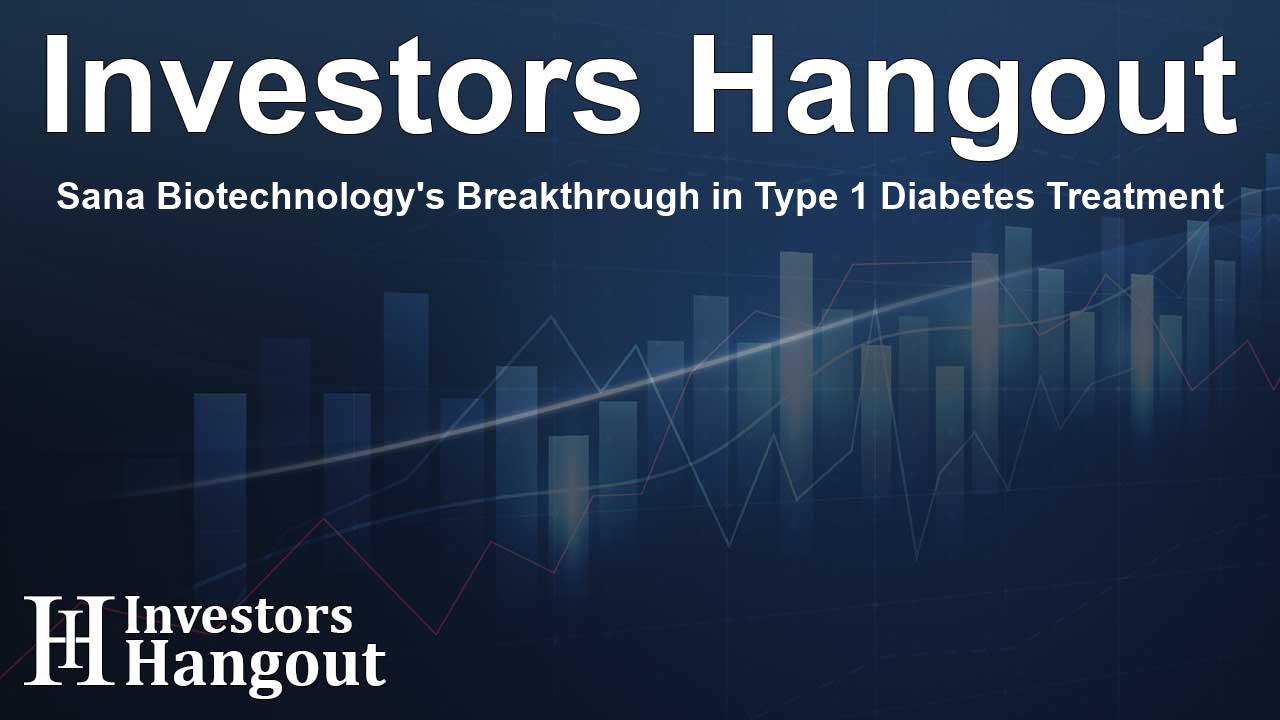Sana Biotechnology's Breakthrough in Type 1 Diabetes Treatment

Revolutionary Advances in Type 1 Diabetes Treatment
Sana Biotechnology, Inc. (NASDAQ: SANA) has recently announced promising clinical results that could significantly change the landscape of Type 1 diabetes treatment. The company is at the forefront of innovating engineered cells aimed at transforming medical therapies. Their latest first-in-human study has showcased their Hypoimmune (HIP) technology, which facilitates pancreatic islet cell transplantation while eliminating the need for immunosuppression.
Study Overview and Results
This groundbreaking study involved the transplantation of UP421, an allogeneic primary islet cell therapy developed using Sana’s cutting-edge HIP technology. Conducted in collaboration with Uppsala University Hospital, the study focused on a patient with Type 1 diabetes. Results revealed that four weeks post-transplantation, there was evidence of functional pancreatic beta cells, shown by circulating C-peptide, a critical marker for insulin production. These findings affirm the potential for islet cells to thrive without the traditional immunosuppression therapies that patients typically rely on.
Patient Monitoring and Functionality
As part of the study, researchers observed the beta cells via consistent levels of C-peptide in the patient’s blood, which further validated the efficiency of the transplanted islet cells. Notably, C-peptide levels surged during a mixed meal tolerance test (MMTT), reflecting the cells' active response to dietary intake. This progressive increase suggests that the engineered cells are functioning effectively, allowing for improved metabolic management.
Safety and Efficacy
The study also conducted MRI scans that indicated sustained signals at the site of implantation, suggesting that the graft has not only survived but is actively functioning. Importantly, no safety issues were identified throughout the study, reinforcing the viability of this treatment option. The HIP-modified islet cells demonstrated a remarkable ability to avoid immune rejection, which is a significant hurdle in cell transplantation.
Expert Insights and Expectations
Prominent figures in the field, such as Per-Ola Carlsson, MD, a principal investigator for the study, expressed optimism regarding the safe handling of islet cell transplants without immunosuppression. He noted that this study represents a significant step toward developing a scalable and curative treatment for Type 1 diabetes.
Comments from the Leadership
Steve Harr, President and CEO of Sana, declared that the successful evasion of the immune detection in an allogeneic transplant speaks volumes about the future possibilities in diabetes treatments. He emphasized that this research can potentially facilitate similar breakthroughs for other conditions requiring cell transplantation.
Community Support and Collaborations
The collaboration extends beyond just institutional partnerships; organizations like Breakthrough T1D have played a vital role in supporting such innovative research initiatives. CEO Aaron Kowalski articulated the community's hope for a cure and the importance of collective efforts towards that aim.
Operational Insights
Today’s advancements are a testament to the dedicated efforts of researchers and medical professionals operating under the HIP framework. Sana plans to expand its research and is looking forward to upcoming presentations where the results can be shared with the wider medical and scientific community.
About Sana Biotechnology
Sana Biotechnology operates with a clear mission: to harness the groundbreaking potential of engineered cells as medical therapies to revolutionize patient care. By focusing on repairing and controlling genetic issues, they aim to provide cures for diseases that were previously deemed untreatable. Based in multiple locations, including Seattle, Cambridge, and South San Francisco, Sana remains a leading innovator in the biotechnology sector. Their commitment to developing scalable therapeutic solutions continues to push the boundaries of science.
Frequently Asked Questions
What is the Hypoimmune (HIP) technology?
HIP technology is designed to allow transplanted cells to evade the recipient's immune response, making it possible to transplant without immunosuppression.
What results have been observed from the recent study?
The study showed that transplanted pancreatic islet cells produced consistent insulin indicators without immunosuppression, demonstrating their survival and functionality.
What potential does this study hold for diabetes treatment?
This study offers hope for scalable and effective treatments for Type 1 diabetes by eliminating the need for immunosuppressive therapies.
Who were the partners in this research effort?
The study was conducted in collaboration with Uppsala University Hospital, allowing for rigorous testing of the new technology.
How can individuals learn more about Sana Biotechnology?
For more information, interested individuals can visit Sana Biotechnology's official website, where they provide updates on ongoing research and advancements.
About The Author
Contact Evelyn Baker privately here. Or send an email with ATTN: Evelyn Baker as the subject to contact@investorshangout.com.
About Investors Hangout
Investors Hangout is a leading online stock forum for financial discussion and learning, offering a wide range of free tools and resources. It draws in traders of all levels, who exchange market knowledge, investigate trading tactics, and keep an eye on industry developments in real time. Featuring financial articles, stock message boards, quotes, charts, company profiles, and live news updates. Through cooperative learning and a wealth of informational resources, it helps users from novices creating their first portfolios to experts honing their techniques. Join Investors Hangout today: https://investorshangout.com/
The content of this article is based on factual, publicly available information and does not represent legal, financial, or investment advice. Investors Hangout does not offer financial advice, and the author is not a licensed financial advisor. Consult a qualified advisor before making any financial or investment decisions based on this article. This article should not be considered advice to purchase, sell, or hold any securities or other investments. If any of the material provided here is inaccurate, please contact us for corrections.
